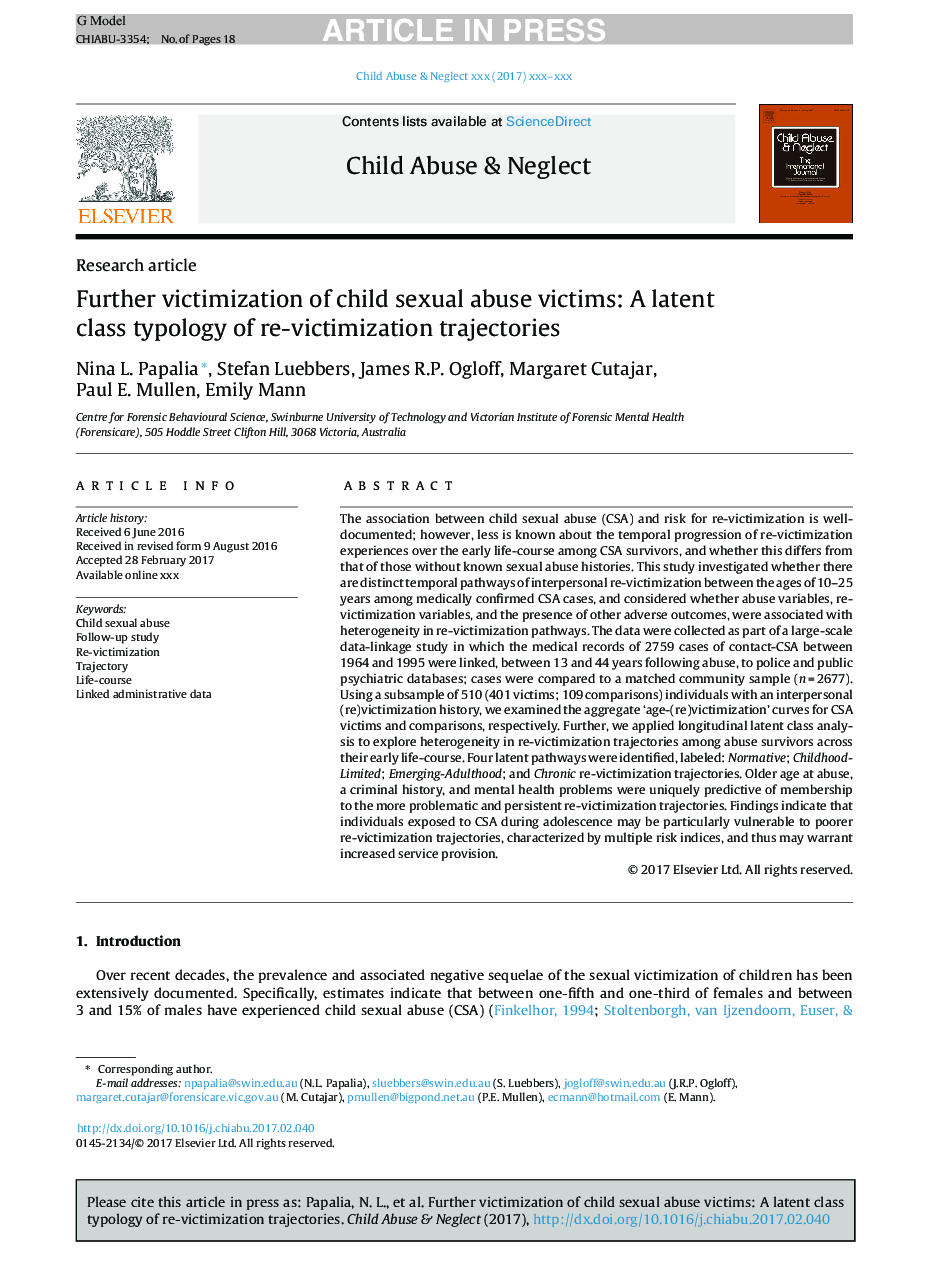| کد مقاله | کد نشریه | سال انتشار | مقاله انگلیسی | نسخه تمام متن |
|---|---|---|---|---|
| 4935967 | 1434362 | 2017 | 18 صفحه PDF | دانلود رایگان |
عنوان انگلیسی مقاله ISI
Further victimization of child sexual abuse victims: A latent class typology of re-victimization trajectories
ترجمه فارسی عنوان
قربانی شدن بیشتر قربانیان سوء استفاده جنسی از کودکان: یک نوع پنهان طبقه بندی مسیرهای مجازات مجدد
دانلود مقاله + سفارش ترجمه
دانلود مقاله ISI انگلیسی
رایگان برای ایرانیان
کلمات کلیدی
سوء استفاده جنسی از کودک، مطالعه پیگیری، مجازات مجدد مسیر دوره زندگی، داده های اداری مرتبط،
موضوعات مرتبط
علوم پزشکی و سلامت
پزشکی و دندانپزشکی
پریناتولوژی (پزشکی مادر و جنین)، طب اطفال و بهداشت کودک
چکیده انگلیسی
The association between child sexual abuse (CSA) and risk for re-victimization is well-documented; however, less is known about the temporal progression of re-victimization experiences over the early life-course among CSA survivors, and whether this differs from that of those without known sexual abuse histories. This study investigated whether there are distinct temporal pathways of interpersonal re-victimization between the ages of 10-25 years among medically confirmed CSA cases, and considered whether abuse variables, re-victimization variables, and the presence of other adverse outcomes, were associated with heterogeneity in re-victimization pathways. The data were collected as part of a large-scale data-linkage study in which the medical records of 2759 cases of contact-CSA between 1964 and 1995 were linked, between 13 and 44 years following abuse, to police and public psychiatric databases; cases were compared to a matched community sample (n = 2677). Using a subsample of 510 (401 victims; 109 comparisons) individuals with an interpersonal (re)victimization history, we examined the aggregate 'age-(re)victimization' curves for CSA victims and comparisons, respectively. Further, we applied longitudinal latent class analysis to explore heterogeneity in re-victimization trajectories among abuse survivors across their early life-course. Four latent pathways were identified, labeled: Normative; Childhood-Limited; Emerging-Adulthood; and Chronic re-victimization trajectories. Older age at abuse, a criminal history, and mental health problems were uniquely predictive of membership to the more problematic and persistent re-victimization trajectories. Findings indicate that individuals exposed to CSA during adolescence may be particularly vulnerable to poorer re-victimization trajectories, characterized by multiple risk indices, and thus may warrant increased service provision.
ناشر
Database: Elsevier - ScienceDirect (ساینس دایرکت)
Journal: Child Abuse & Neglect - Volume 66, April 2017, Pages 112-129
Journal: Child Abuse & Neglect - Volume 66, April 2017, Pages 112-129
نویسندگان
Nina L. Papalia, Stefan Luebbers, James R.P. Ogloff, Margaret Cutajar, Paul E. Mullen, Emily Mann,
